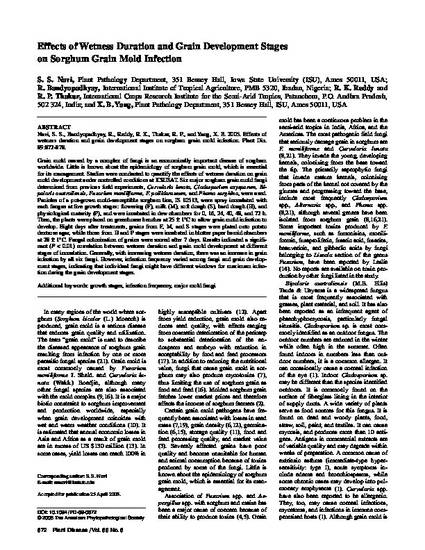
Article
Effects of Wetness Duration and Grain Development Stages on Sorghum Grain Mold Infection
Plant Pathology and Microbiology Publications
Document Type
Article
Disciplines
Publication Date
8-1-2005
Abstract
Grain mold caused by a complex of fungi is an economically important disease of sorghum worldwide. Little is known about the epidemiology of sorghum grain mold, which is essential for its management. Studies were conducted to quantify the effects of wetness duration on grain mold development under controlled conditions at ICRISAT. Six major sorghum grain mold fungi determined from previous field experiments,Curvularia lunata, Cladosporium oxysporum, Bipolaris australiensis, Fusarium moniliforme, F. pallidoroseum, and Phoma sorghina, were used. Panicles of a pot-grown mold-susceptible sorghum line, IS 10513, were spray inoculated with each fungus at five growth stages: flowering (F), milk (M), soft dough (S), hard dough (H), and physiological maturity (P), and were incubated in dew chambers for 0, 16, 24, 40, 48, and 72 h. Then, the plants were placed on greenhouse benches at 25 ± 1°C to allow grain mold infection to develop. Eight days after treatments, grains from F, M, and S stages were plated onto potato dextrose agar, while those from H and P stages were incubated in blotter paper humid chambers at 28 ± 1°C. Fungal colonization of grains were scored after 7 days. Results indicated a significant (P < 0.01) correlation between wetness duration and grain mold development at different stages of inoculation. Generally, with increasing wetness duration, there was an increase in grain infection by all six fungi. However, infection frequency varied among fungi and grain development stages, indicating that individual fungi might have different windows for maximum infection during the grain development stages.
Copyright Owner
The American Phytopathological Society
Copyright Date
2005
Language
en
File Format
application/pdf
Citation Information
Shrishail Sharanappa Navi, R. Bandyopadhvay, R. K. Reddy, R. P. Thakur, et al.. "Effects of Wetness Duration and Grain Development Stages on Sorghum Grain Mold Infection" (2005) Available at: http://works.bepress.com/shrishail_navi/38/

This article is from Plant Disease, 89, no. 8 (August 2005): 872–878, doi: 10.1094/PD-89-0872.